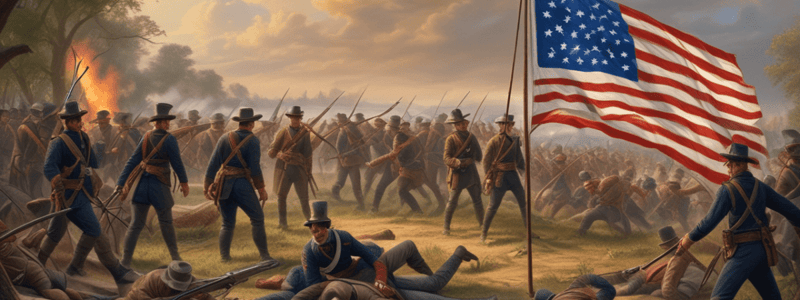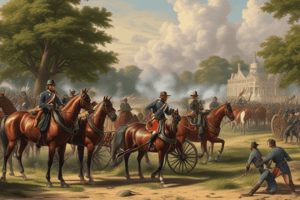Podcast
Questions and Answers
Which of the following statements about the Battle of Fredericksburg is true?
Which of the following statements about the Battle of Fredericksburg is true?
- Union forces aimed to position themselves between Lee's army and Richmond. (correct)
- It took place after the Battle of Antietam.
- It was a Union victory under General McClellan.
- The battle resulted in a stalemate between the Union and Confederate forces.
What was a significant outcome of the Battle of Antietam?
What was a significant outcome of the Battle of Antietam?
- It persuaded Britain and France not to recognize the Confederacy. (correct)
- It resulted in the complete surrender of Lee's Confederate forces.
- It convinced Britain and France to recognize the Confederacy.
- It led to the capture of the Confederate capital, Richmond.
Which of the following statements about the Civil War battles in Missouri is NOT true?
Which of the following statements about the Civil War battles in Missouri is NOT true?
- Confederate forces, led by General Sterling Price, used guerilla warfare tactics.
- Missouri did not officially secede from the Union, but both sides claimed it.
- Over 1,000 battles were fought in the state of Missouri.
- Union troops were sent to Missouri to support the Confederate government there. (correct)
What was the significance of controlling the Mississippi River during the Civil War?
What was the significance of controlling the Mississippi River during the Civil War?
Which of the following battles took place in the Trans-Mississippi Theater?
Which of the following battles took place in the Trans-Mississippi Theater?
Which key factor contributed to the Union's initial advantages over the Confederacy at the start of the Civil War?
Which key factor contributed to the Union's initial advantages over the Confederacy at the start of the Civil War?
What was the primary reason many Southerners seceded from the Union and formed the Confederate States of America?
What was the primary reason many Southerners seceded from the Union and formed the Confederate States of America?
What was the goal of General Winfield Scott's Anaconda Plan during the Civil War?
What was the goal of General Winfield Scott's Anaconda Plan during the Civil War?
Which of the following was NOT a significant factor that contributed to the Union's initial advantages over the Confederacy?
Which of the following was NOT a significant factor that contributed to the Union's initial advantages over the Confederacy?
Why did General Winfield Scott hope to end the Civil War with a minimal loss of life through the Anaconda Plan?
Why did General Winfield Scott hope to end the Civil War with a minimal loss of life through the Anaconda Plan?
What was the primary objective of the Anaconda Plan?
What was the primary objective of the Anaconda Plan?
Why did General McClellan face criticism from President Lincoln?
Why did General McClellan face criticism from President Lincoln?
What was the significance of the Battle of Hampton Roads?
What was the significance of the Battle of Hampton Roads?
Why was Virginia a crucial battleground during the Civil War?
Why was Virginia a crucial battleground during the Civil War?
How did the Battle of Antietam impact international relations during the Civil War?
How did the Battle of Antietam impact international relations during the Civil War?
What was the primary reason for General Grant pausing his advance down the Tennessee River after capturing Fort Henry?
What was the primary reason for General Grant pausing his advance down the Tennessee River after capturing Fort Henry?
Which state saw particularly intense fighting during the Civil War despite not officially seceding from the Union?
Which state saw particularly intense fighting during the Civil War despite not officially seceding from the Union?
What control over Missouri meant control over during the Civil War?
What control over Missouri meant control over during the Civil War?
At the Battle of Kirksville, which side established northeastern Missouri under their control?
At the Battle of Kirksville, which side established northeastern Missouri under their control?
What was the primary motivation behind the Southern states seceding from the Union?
What was the primary motivation behind the Southern states seceding from the Union?
What was the primary advantage the Union had over the Confederacy at the start of the Civil War?
What was the primary advantage the Union had over the Confederacy at the start of the Civil War?
What was the underlying principle behind General Winfield Scott's Anaconda Plan?
What was the underlying principle behind General Winfield Scott's Anaconda Plan?
Why were the states of Virginia and Missouri significant battlegrounds during the Civil War?
Why were the states of Virginia and Missouri significant battlegrounds during the Civil War?
Which of the following statements best describes the initial expectations regarding the Confederacy's chances of success?
Which of the following statements best describes the initial expectations regarding the Confederacy's chances of success?
What was the primary goal of the Anaconda Plan proposed by General Winfield Scott?
What was the primary goal of the Anaconda Plan proposed by General Winfield Scott?
Why was General McClellan criticized by President Lincoln for his handling of the Peninsula Campaign?
Why was General McClellan criticized by President Lincoln for his handling of the Peninsula Campaign?
What was the significance of the Battle of Hampton Roads during the Civil War?
What was the significance of the Battle of Hampton Roads during the Civil War?
Why was the Shenandoah Valley an important strategic location for the Confederacy during the Civil War?
Why was the Shenandoah Valley an important strategic location for the Confederacy during the Civil War?
Flashcards are hidden until you start studying
Study Notes
The Civil War: 1862
- The United States was in the early stages of the Civil War in 1862.
- Several Southern states had seceded from the Union in the previous year over the election of President Abraham Lincoln, who was mainly elected on a strong anti-slavery platform.
- The Southern States declared a new nation, the Confederate States of America, with Jefferson Davis as their President.
The Anaconda Plan
- The Anaconda Plan was devised by General Winfield Scott to end the war with a minimal loss of life.
- The plan aimed to surround and squeeze the Confederacy into submission.
- The plan had two main components: a naval blockade of Confederate ports along the Atlantic Coast and the Gulf of Mexico, and controlling the Mississippi River.
- The plan was slow to enact and required patience.
Civil War Battles in Virginia
- Virginia saw a great deal of fighting during the Civil War.
- The state had more factories than any other state in the Confederacy, which the Union sought to control or destroy to cripple the South's supplies.
- The Confederate capital was Richmond, less than four days' march from Washington D.C.
- Over 120 battles were fought in Virginia by the end of the war.
The Peninsula Campaign
- In the spring of 1862, General McClellan sailed his troops south to Fort Monroe and marched north towards Richmond.
- McClellan's lack of aggressiveness proved costly to the Union when he met Confederate resistance at Yorktown.
- He began a time-consuming siege instead of attacking outright, allowing Confederate reinforcements to arrive and drive McClellan back out of Virginia.
The Valley Campaign
- General Thomas "Stonewall" Jackson clashed with Union troops in the Shenandoah Valley.
- Although outnumbered, Jackson pushed his troops hard, outmaneuvering the Union armies and keeping their attention focused on the Valley instead of making their way to Richmond.
The Battle of Hampton Roads
- In March 1862, the Union ship USS Monitor clashed with the Confederate ship CSS Virginia.
- This significant battle marked the first time two ironclad warships faced off against each other.
- The skirmish ended in a stalemate, but the Monitor successfully prevented the Virginia from breaking the Union blockade.
The Second Battle of Bull Run
- In keeping with the goal to capture Richmond, President Lincoln ordered the creation of the Army of Virginia under the command of Maj. Gen. John Pope.
- Confederate General Robert E. Lee crushed the Union forces and advanced across the Potomac River into Northern territory.
The Battle of Fredericksburg
- Union Major General Ambrose E. Burnside, replacing General McClellan, hoped to get in between General Lee and Richmond.
- The battle ended with a Confederate victory.
The Battle of Antietam
- The Battle of Antietam in 1862 was the deadliest one-day battle of the Civil War.
- General Lee brought his entire force North, hoping to bring the fighting into Union territory.
- The battle stopped Lee's advance northward and persuaded the British and French not to recognize the Confederacy.
Civil War Battles in Missouri
- Fighting was intense in the border state of Missouri, with over 1,000 battles fought there.
- Although Missouri did not officially secede from the Union, both sides claimed it and established governments there.
- The Confederate forces, led by General Sterling Price, used guerilla warfare.
- Union troops were sent in to protect the public, led by Major General Henry W. Halleck.
The Trans-Mississippi Theater
- Control of Missouri meant control of the vital Mississippi River.
- The river was crucial for the movement of troops, communications, and Confederate supplies.
- President Lincoln knew that controlling the river would cut the Confederacy in half and limit aid and supplies to Richmond.
Battle of Shiloh
- Union General Ulysses S. Grant had been making his way down the Tennessee River.
- The Confederacy saw an opportunity to attack before Grant's reinforcements could arrive.
- Grant's reinforcements arrived quickly and forced a Confederate retreat.
The Battle of Kirksville
- At the Battle of Kirksville, Union Colonel John McNeil defeated Confederate Colonel Joseph C. Porter.
- The battle established northeastern Missouri under Union control.
The Battle of Compton's Ferry and Yellow Creek
- In August 1862, Union Colonel Odon Guitar encountered Confederate Colonel John A. Poindexter at Compton Ferry.
- The Rebels were routed, and the Union army captured a large amount of ammunition and supplies.
- Guitar pursued the Confederate forces to Yellow Creek and wiped them out.
Studying That Suits You
Use AI to generate personalized quizzes and flashcards to suit your learning preferences.




